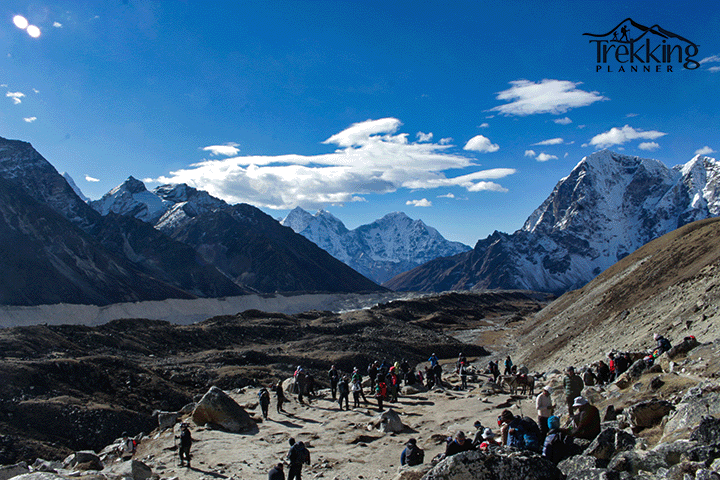Those who have been to Nepal more than once may not be surprised by the diversity of the country's seasons. But it can be challenging to understand for those who haven't had the chance.
- Basanta Ritu ( Mid- March to Mid-May)
- Grishma Ritu (Mid-May to Mid- July)
- Barsha Ritu (Mid- July to Mid-September)
- Sharad Ritu (Mid- September to Mid- November)
- Hemanta Ritu (Mid-November to Mid-January)
- Shishir Ritu (Mid- January to Mid-March)
In general, there are four distinct seasons in the world: spring, summer, fall, and winter. However, Nepal has six distinct seasons, including Basanta (Spring), Grishma (Early Summer), Barkha (Summer Monsoon), Sharad (Early Autumn), Hemanta (Late Autumn), and Shishir (Winter). The geology of this magnificent mountainous terrain has led to the development of these six different seasons. Cracking the different seasons of Nepal.
Best Season for Everest Base Camp Trekking
Most trekkers choose September and November to hike to Everest Base Camp because of the beautiful skies and stunning Himalayan views at this time. Trekking in December is considered the best season as every trekking route of the country is crowded with trekkers, both foreign tourists, and local Nepali trekkers. Due to the colder weather and increased likelihood of snowfall after November, this period is regarded as the off-season.
The Everest Base Camp Trek in December
The start of the coldest month of the year is December which might extend through the end of January. You have to walk on this trek from low-altitude to high-altitude regions reaching 5,600 meters. Because of this, the Everest Base Camp Trek weather in December is completely dynamic. Every trip to Everest Base Camp begins with a beautiful flight from Kathmandu to Lukla. Due to the high volume of visitors going during the peak season, getting tickets for flights to Lukla is quite challenging. Days must pass until you receive your tickets, but if you're going to Everest Base Camp in December, you'll have an easier time getting tickets.
Lower elevation places like Lukla, Phakding, Namche, and Tengboche see sunny, warm days and chilly, tolerably cold evenings. However, the days are mild and somewhat cold at higher altitude places like Dingboche, Lobuche, Gorakshep, EBC, and Kala Patthar, but the nights are very cold and can exceed zero degrees.

Traveling to EBC in the winter has numerous advantages, not the least of which is that there are fewer people there to overcrowd the camp. Thousands of visitors flock to this major tourist destination in the autumn to catch a glimpse of the highest mountain in the world. Many people think that trekking to the Everest Region in the winter is extremely cold, therefore avoid going from December to February. They couldn't be more mistaken, as a journey in the winter is far more interesting and more thrilling than one in the autumn.
The majority of trekkers avoid their Mount Everest Base Camp Trek in December out of concern about bad weather, limited views, and scenery, poor lodging, etc. You can walk in the open in December without being bothered by other EBC Trekkers. Trekking on paths that are empty adds adventure and thrills to your journey that are not possible during high seasons. The crowds begin to thin out in December after the hectic months of October and November. While some teahouses close for the winter, and their owners relocate to Kathmandu. But at the locations that do remain open, finding a bed won't be a problem.
We also have our Helicopter Packages, where you can enjoy a birds-eye view of the majestic Mt. Everest and the other eight-thousand-meter Himalayas. The EBC offers different packages, ranging from one single day to 14 days, to visit the Everest Region. Check out the blog on What to Expect on our helicopter tour of the EBC.
Explore our Everest Heli Tour Packages
Helicopter Ride From Kathmandu to Lukla - 40 min
Namche to Everest Base Camp Helicopter Tour -1 Day
Rapid Everest Base Camp Trek (Heli flight back to Lukla)
Everest View Trek With Gokyo Helicopter Tour-5 Days
11 Days Everest Base Camp Trek with Helicopter Return
Conclusion
Every year, we welcome thousands of novice and expert trekkers from all over the world to Nepal. Although spring and fall are popular times for treks to the Himalayas, the real thrill is in the winter. We at Trekking Planner (P.) Ltd. has unique winter trekking packages.
So, if you're considering visiting Nepal during the winter, contact us immediately, and we'll give you our recommendations for the best packages.
Explore Nepal Trekking Planner's Everest Base Camp Trekking Packages:
Everest Base Camp Trekking: 15 Days
Everest Luxury Lodge Trekking-14 Days





